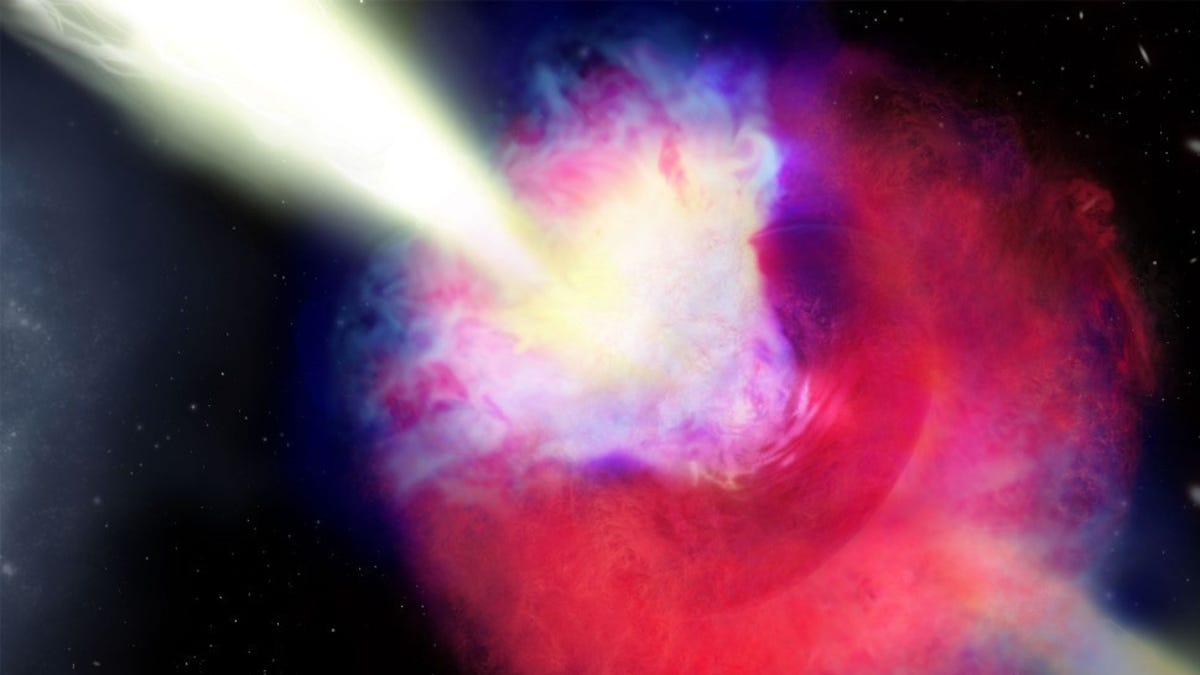Epic Cosmic Blast Is Unlike Anything Astronomers Have Seen Before
A long gamma ray burst, one of the most powerful phenomena known, was traced back to a rare kilonova, leaving astrophysicists baffled.

Artist's impression of GRB 211211A. The kilonova and gamma-ray burst is on the right.
Highly energetic blasts from across the universe called long gamma ray bursts have long been connected to the collapse of massive stars, but astronomers say they've traced a nearly minute-long burst to a surprising and rare phenomenon, challenging long-held scientific beliefs about some of the most powerful objects in the universe.
Astrophysicists spotted a 50-second GRB (any GRB over two seconds is classified as a long GRB) in December 2021, which was cataloged as GRB211211A and estimated to be situated about a billion light-years from Earth -- close on the scale of the universe. Upon more detailed investigation, they were stunned to track the burst back to a kilonova, a rare event resulting from a highly dense neutron star merging with a compact, powerful object like a black hole or another neutron star.
"This event looks unlike anything else we have seen before from a long gamma-ray burst," Northwestern University doctoral student Jillian Rastinejad, said in a statement. "This event represents an exciting paradigm shift for gamma-ray burst astronomy."
Rastinejad led a study on the discovery published Wednesday in the journal Nature.
"When I entered the field 15 years ago, it was set in stone that long gamma-ray bursts come from massive star collapses," added Northwestern professor and study senior author Wen-fai Fong.
Fong explains it's weird to see such a long GRB tied to a kilonova instead of an imploding star.
"When you put two neutron stars together, there's not really much mass there," she said. "A little bit of mass accretes and then powers a very short-duration burst. In the case of massive star collapses, which traditionally power longer gamma-ray bursts, there is a longer feeding time."
"This detection breaks our standard idea of gamma-ray bursts," adds Eve Chase, also a co-author on the paper from Los Alamos National Laboratory. "We now realize that gamma-ray bursts are much harder to classify. This detection pushes our understanding of gamma-ray bursts to the limits."
The galaxy that hosts this kilonova is also unexpected, because it's younger and still forming stars, nearly the opposite from the galaxy where the only other known neutron star merger relatively close to Earth was observed.
"I think it changes our view of the types of galaxies we should watch when we're searching for nearby kilonovas," said Anya Nugent, a Northwestern Ph.D. student in astronomy and study co-author.
A related study, published in Nature Astronomy, looks a little more deeply at the properties of the event behind the burst, which might help explain other mysterious GRBs that don't quite fit the mold.
"We don't expect mergers to last more than about two seconds. Somehow, this one powered a jet for almost a full minute," says lead author Benjamin Gompertz from the University of Birmingham in the UK. "It's possible the behavior could be explained by a long-lasting neutron star, but we can't rule out that what we saw was a neutron star being ripped apart by a black hole. Studying more of these events will help us determine which is the right answer."
The James Webb Space Telescope is among the new powerful tools scientists will be able to use to study kilonovas in more depth and also perhaps witness the formation of some of the heavier elements in the universe -- which are associated with neutron stars -- for the first time.

